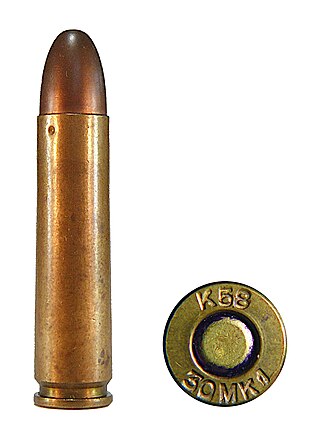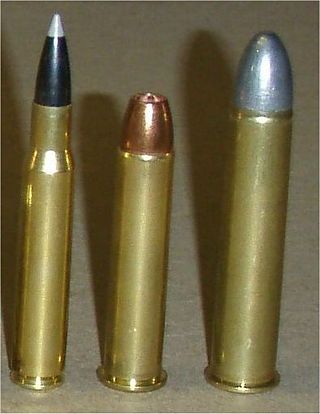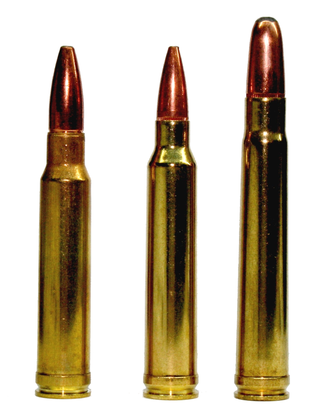
In firearm designs, the term single-shot refers to guns that can hold only a single round of ammunition inside and thus must be reloaded manually after every shot. Compared to multi-shot repeating firearms ("repeaters"), single-shot designs have no moving parts other than the trigger, hammer/firing pin or frizzen, and therefore do not need a sizable receiver behind the barrel to accommodate a moving action, making them far less complex and more robust than revolvers or magazine/belt-fed firearms, but also with much slower rates of fire.

The 5.56×45mm NATO is a rimless bottlenecked intermediate cartridge family developed in the late 1970s in Belgium by FN Herstal. It consists of the SS109, L110, and SS111 cartridges. On 28 October 1980, under STANAG 4172, it was standardized as the second standard service rifle cartridge for NATO forces as well as many non-NATO countries. Though they are not entirely identical, the 5.56×45mm NATO cartridge family was derived from and is dimensionally similar to the .223 Remington cartridge designed by Remington Arms in the early 1960s.

The .50 Browning Machine Gun is a .50 in (12.7 mm) caliber cartridge developed for the M2 Browning heavy machine gun in the late 1910s, entering official service in 1921. Under STANAG 4383, it is a standard service cartridge for NATO forces as well as many non-NATO countries. The cartridge itself has been made in many variants: multiple generations of regular ball, tracer, armor-piercing (AP), incendiary, and saboted sub-caliber rounds. The rounds intended for machine guns are made into a continuous belt using metallic links.

Rimfire ammunition is a type of firearm metallic cartridge whose primer is located within a hollow circumferential rim protruding from the base of its casing. When fired, the gun's firing pin will strike and crush the rim against the edge of the barrel breech, sparking the primer compound within the rim, and in turn ignite the propellant within the case. Invented in 1845, by Louis-Nicolas Flobert, the first rimfire metallic cartridge was the .22 BB Cap cartridge, which consisted of a percussion cap with a bullet attached to the top. While many other different cartridge priming methods have been tried since the mid-19th century onwards, only rimfire and the later centerfire cartridges survive to the present day with regular usages. The .22 Long Rifle rimfire cartridge, introduced in 1887, is by far the most common ammunition in the world today in terms of units sold.
The .30-06 Springfield cartridge, 7.62×63mm in metric notation, and called the .30 Gov't '06 by Winchester, was introduced to the United States Army in 1906 and later standardized; it remained in military use until the late 1970s. The ".30" refers to the caliber of the bullet in inches, .300 and the "06" refers to the year the cartridge was adopted, 1906. It replaced the .30-03, 6mm Lee Navy, and .30-40 Krag cartridges. The .30-06 remained the U.S. Army's primary rifle and machine gun cartridge for nearly 50 years before being replaced by the 7.62×51mm NATO and 5.56×45mm NATO, both of which remain in current U.S. and NATO service. It remains a very popular sporting round, with ammunition produced by all major manufacturers.

The .30 Carbine (7.62×33mm) is a rimless carbine/rifle cartridge used in the M1 carbine introduced in the 1940s. It is a light rifle round designed to be fired from the M1 carbine's 18-inch (458 mm) barrel.
The .256 Winchester Magnum is a firearms cartridge developed by Winchester, and was produced by necking-down a .357 Magnum cartridge to .257 diameter. It was designed for shooting small game and varmints.

The .218 Bee is a .22 caliber centerfire rifle cartridge designed for varmint hunting by Winchester in 1937. The cartridge was originally chambered in the Winchester Model 65 lever-action rifles, which may have ultimately led to its lack of popularity. The cartridge is named for the bore diameter of the barrel in which the cartridge is chambered rather than the usual practice in the United States of having the cartridge's nomenclature reflect in some way the bullet diameter.

The .45-70, also known as the .45-70 Government and the .45-70 Springfield, is a .45 caliber rifle cartridge originally holding 70 grains of black powder that was developed at the U.S. Army's Springfield Armory for use in the Springfield Model 1873. It was a replacement for the stop-gap .50-70 Government cartridge, which had been adopted in 1866, one year after the end of the American Civil War, and is known by collectors as the "Trapdoor Springfield".

John Dean "Jeff" Cooper was a United States Marine, the creator of a "modern technique" of handgun shooting, and an expert on the use and history of small arms.
The .376 Steyr cartridge is a rifle cartridge jointly developed by Hornady and Steyr for use in the Steyr Scout rifle.

The .300 Winchester Magnum is a belted, bottlenecked Magnum rifle cartridge that was introduced by the Winchester Repeating Arms Company in 1963. The .300 Winchester Magnum is a magnum cartridge designed to fit in a standard rifle action. It is based on the .375 H&H Magnum, which has been blown out, shortened, and necked down to accept a .30 caliber (7.62 mm) bullet.

The .444 Marlin (10.9×57mmR) is a rifle cartridge designed in 1964 by Marlin Firearms and Remington Arms. It was designed to fill in a gap left by the older .45-70 when that cartridge was not available in any new lever-action rifles; at the time it was the largest lever-action cartridge available. The .444 resembles a lengthened .44 Magnum and provides a significant increase in velocity. It is usually used in the Marlin 444 lever-action rifle. Currently, Marlin, who is now owned by Ruger Firearms, does not offer the .444 chambering in any of their rifles. It remains to be seen when or if they will bring the chambering back into production.

The .338 Winchester Magnum is a .338 in (8.6 mm) caliber, belted, rimless, bottlenecked cartridge introduced in 1958 by Winchester Repeating Arms. It is based on the blown-out, shortened .375 H&H Magnum. The .338 in (8.6 mm) is the caliber at which medium-bore cartridges are considered to begin. The .338 Winchester Magnum is the first choice among professional brown bear guides in Alaska to back up clients where a powerful stopping caliber is required on charging bears. It is also the most popular medium-bore cartridge in North America and has the most widely available choice in rifles among medium bore rifles. The action length is the same as a .30-06, and most major rifle manufacturers in the United States chamber rifles for the cartridge including the semi-automatic Browning BAR Mk II Safari, making it a very powerful combination against charging dangerous game. The cartridge was intended for larger North American big-game species and has found use as for the hunting of thin-skinned African plains-game species.

The .30-378 Weatherby Magnum is a .30 caliber, belted, bottle-necked rifle cartridge. The cartridge was developed in response to a US Army military contract in 1959. While still unreleased to the public, the cartridge went on to set world records for accuracy including the first ten 10X in 1,000 yards (910 m) benchrest shooting. It is currently the highest velocity .30 caliber factory ammunition available.
The .416 Barrett or 10.4×83mm centerfire rifle cartridge is a proprietary bottlenecked centrefire rifle cartridge designed in 2005. It is an alternative to the large-caliber .50 BMG in long-range high-power rifles. It was designed in response to a request for a medium/heavy rifle cartridge combination that was issued from Naval Surface Warfare Center Crane Division in late 2004.

The .450 Bushmaster is a rifle cartridge developed by Tim LeGendre of LeMag Firearms, and licensed to Bushmaster Firearms International. The .450 Bushmaster is designed to be used in standard M16s and AR-15s, using modified magazines and upper receiver assemblies.
The 6×45mm is a rimless, bottlenecked cartridge based on the .223 Remington or 5.56 NATO cartridge necked up to .243 (6mm). The cartridge is also known as the 6mm-223 Remington or 6mm/223.
The .32 Winchester Self-Loading is an American rifle cartridge.

Varmint rifle is an English term for a small-caliber precision firearm or high-powered airgun primarily used for both varmint hunting and pest control. These tasks include killing three types of pests or nuisance animals that spread diseases or destroy crops or livestock:













